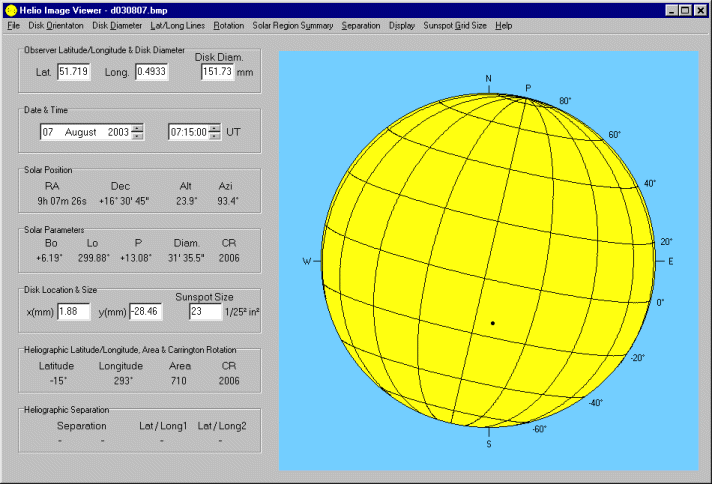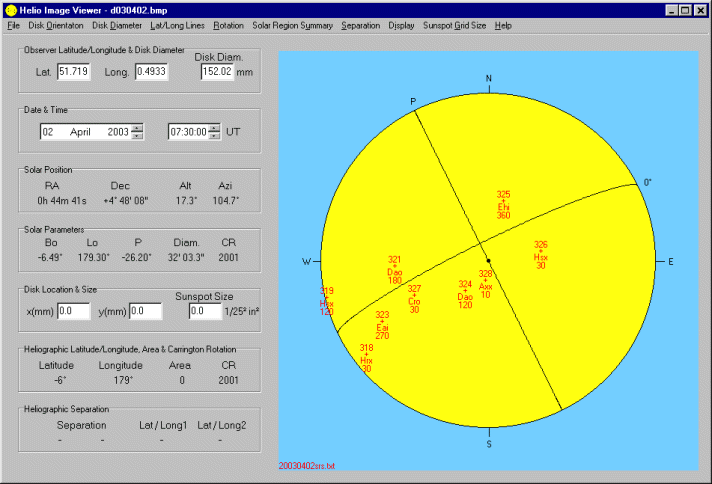|
This Windows freeware program is used for the calculation of sunspot locations and their area plus much more. Below are a selection of screen shots showing various aspects of the program (note that the screen shots have be reduced in size to fit the width of the Solar Observing web pages).
In addition to the artifical Sun (yellow on blue background), Helio Viewer can input full disk solar images (such as those on this web site or those with the solar disk surrounded by a black background, in bitmap format). Once input, the centre position and disk diameter are automatical calculated and for those images on this web site, the date is automatically set. Clicking anywhere on the disk with the mouse moves the blue 'sunspot' (in the middle of the largest group above), calculates the x and y position and the solar latitude and longitude (as shown above). If the size of the sunspot is input, its area is calculated.
In addition to the solar equator and the central meridin, other latitude and longitude lines as shown above can be displayed. These can be displayed separately as can the N, E, S and W marks. The distance between any two points on the solar surface can be measured - the red line through the main group has the separation shown in the lower left panal of the Helio Viewer window. There are four types of line: (i) both ends on the solar disk, (ii) one end of the solar disk and the other on the solar limb, (iii) both end outside the solar disk and (iv) one end outside the solar disk and the other on the solar limb. Types (i) and (ii) are suitable for measuring the distance of features on the solar surface while types (iii) and (iv) are for features outside the disk but at the distance of the Sun such as prominences. Also for types (i) and (ii) the line can be at the same latitude (as shown above) or on a great circle which is the shortest distance between two points on a sphere. Finally, the 'sunspot' (blue dot) can be selected to be in the middle of the line for types (i) and (ii).
Closing the input image returns the user to the artifical Sun with the date/time, disk diameter and sunspot unchanged. It is possible to alter the date and/or time and watch the sunspot rotate across the disk, on the averted disk and back on the to visible disk. The rotation can be at a fixed rate which would be the case if the Sun were a solid object (the Carrington rotation rate) and/or where the rotation rate is fastest at the solar equator and slower towards the poles (differential rate). The screen shot below shows when this sunspot will be next on the eastern limb assuming it moves at the differential rotation rate (note that the sunspot longitude has changed slightly due to the differential rotation).
Solar Region Summary (SRS) products from the Space Environment Center (SEC) can be superimposed on either the artifical Sun or an input solar image (as above). The SRS products can be obtained from the SEC web site or by requesting the product to be sent by email. For each group the SRS number, modified Zurich classification and area (in millionths) are shown above and below a '+' which indicates the location of the group given in the SRS product.
As already described closing the input image returns the user to the artifical Sun with the SRS group details still present (shown above). Changing the date and/or time alters the location of the SRS groups so that, for example, it is possible to find out when a particular group will move to the western limb or when it will return from behind the averted disk and back to the eastern limb. The date and/or time can be moved forwards or backwards. Helio Viewer is available from the software web page.
Last updated on 10 January 2007. |





